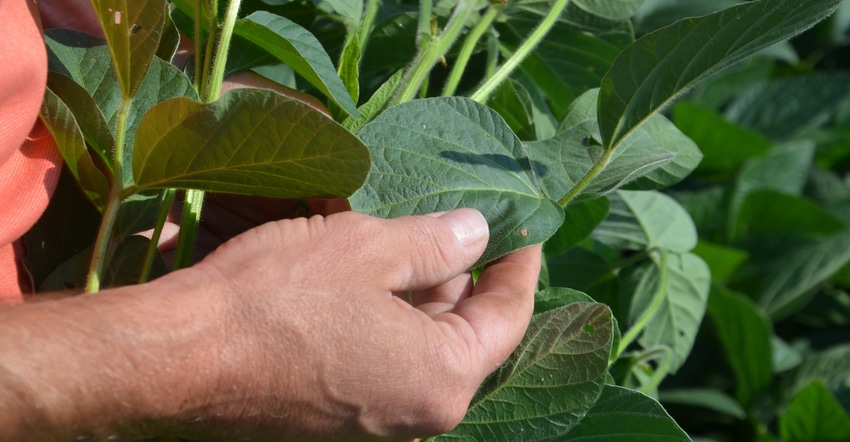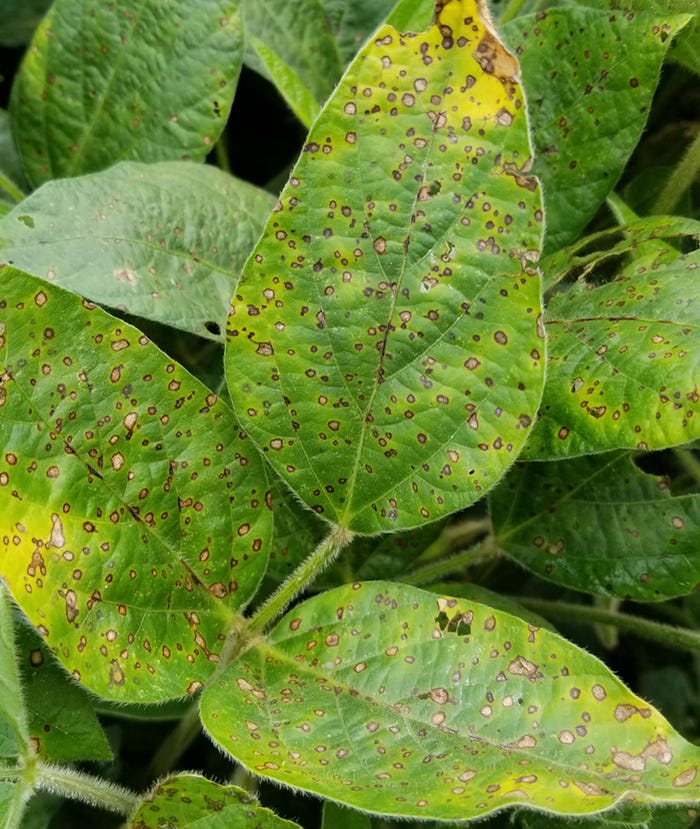May 28, 2020

I’m on the fence about whether to spray soybeans with fungicides. Can you point me to test results or guidelines?
The Indiana certified crop advisers panel answering this question includes Betsy Bower, agronomist, Ceres Solutions, Terre Haute; Jesse Grogan, regional manager, AgReliant Genetics LLC, Lafayette; and Stan Miles, agronomist, A&L Great Lakes Labs, Fort Wayne.
Bower: Two foliar diseases that can lead to yield loss if not managed are frogeye leaf spot and septoria brown spot. Septoria brown spot often infects soybeans early, particularly after wet time periods. It can move up the canopy during grain fill. Frogeye leaf spot can also overwinter here, so if the environment is right, we see infections yearly.
With both diseases, monitor soybeans as early as R2 and as late as R4. So, check your beans over a three-week period. Regarding frogeye leaf spot, check with your seed consultant to understand if you’ve planted a susceptible variety. If so, be ready to spray quickly, even if you find just a few lesions.
If you spray, use fungicides with mixed modes of action. Frogeye is resistant to strobiluron fungicides in many states. There are several mixed mode-of-action fungicides.
Iowa State University has recent data evaluating soybean fungicides. A new resource is the Crop Protection Network. Sign up for a newsletter and get ratings on fungicides.
Grogan: Ag consultants and suppliers usually conduct trials that provide relevant information. Chemical manufacturers also provide useful test results through technical and sales reps. There’s a general response of fungicide use for soybeans, usually a 2- to 4-bushel-per-acre yield advantage. Variety selection, yield level and field environment play a role.
Some varieties benefit more than others. There can be a yield spread of zero to 15 bushels per acre for fungicides, depending on the year and disease pressure. It’s important to target diseases for control. Brown spot is usually not economically important, whereas frogeye leaf spot is a threat. Know the disease history of your fields and what to expect in soybeans.

FROGEYE LEAF SPOT: Here is what frogeye leaf spot looks like once it takes over a soybean leaf.

Tankmix products with more than one mode of action are preferred to reduce development of fungicide resistance. Cost-benefit analysis should be considered when applying fungicides. Best return on investment is in high-yield fields with a history of disease. Best one-time application for foliar diseases is the R3 growth stage, when pods on any of the uppermost four nodes are 3/16-inch long.
Miles: Current soybean market prices means using the sharpest pencil in the drawer to keep this year’s crop budgets in the black. North Central Regional Committee on Soybean Diseases released a comprehensive guide to fungicide efficacy, called CPN-1019-W, in 2018 that provides a head-to-head comparison of many fungicide options. Keep in mind that disease efficacy and reduction of visual symptoms may not result in a positive economic return.
Gather available information from your seed companies to categorize varieties by disease susceptibility ratings and prioritize scouting efforts. Concentrate on early-planted, irrigated locations with dense vegetation and high yield potential. The key to timely application is good preparation.
Research available products for efficacy on diseases most likely to cause economic damage in your environment. Use products that offer multiple modes of action.
You May Also Like




